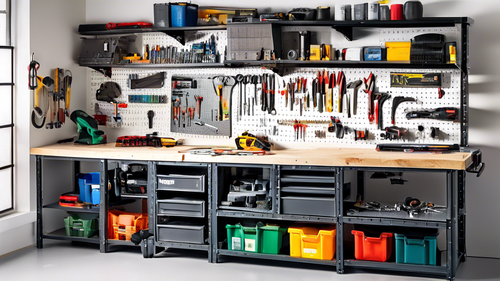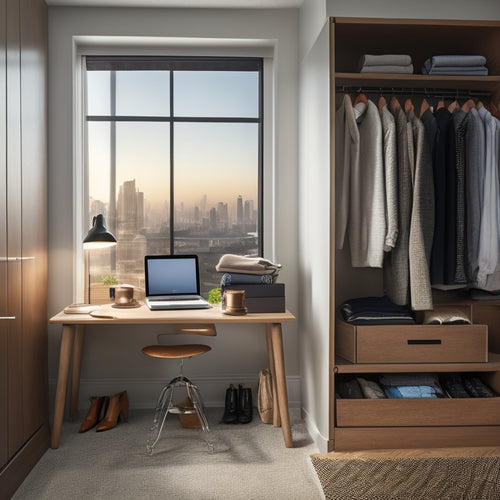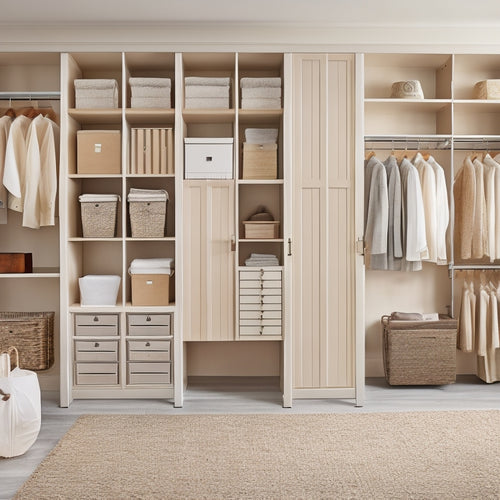
Organizing Cabinetry for Senior-Friendly Homes Made Easy
Share
You can design a senior-friendly home that accommodates your changing needs by incorporating intuitive cabinetry solutions that prioritize accessibility, ergonomics, and ease of use. To get started, focus on ease of access by minimizing joint strain, using drawer dividers, and implementing a "one in, one out" policy. Maximize vertical cabinet space with adjustable shelves and pull-down racks, and choose easy-access cabinet designs like pull-out shelves and lazy susans. By selecting senior-friendly cabinet hardware, you'll create a space that adapts with your needs; now, take the next step towards crafting a home that supports your independence and comfort.
Key Takeaways
- Prioritize ease of access in cabinetry to minimize joint strain and reduce physical exertion for seniors.
- Implement adjustable shelves and dividers to maintain organization and accommodate changing storage needs.
- Choose ergonomic cabinet hardware, such as lever-style handles and soft-close hinges, for easy operation.
- Optimize vertical cabinet space with pull-down racks and baskets to reduce bending and stretching.
- Design cabinetry with adaptive shelving to evolve with seniors' changing needs and abilities.
Simple Storage Solutions for Seniors
As you begin to design senior-friendly homes, one essential aspect to contemplate is simplifying storage solutions to accommodate the unique needs of seniors.
You'll want to prioritize ease of access and minimize strain on joints. Installing drawer dividers can keep contents organized and prevent clutter from building up, much like adopting a one in, one out policy to prevent new clutter accumulation.
Additionally, consider incorporating pull-out shelves that bring items to a comfortable height, reducing the need for bending or straining. This is especially important in clutter-prone areas like kitchens and closets, where clear countertops and organized utensils can make a big difference.
Maximizing Vertical Cabinet Space
Vertical cabinet space is a senior-friendly home's best-kept secret, waiting to be revealed. You can access this potential by optimizing shelf organization to make the most of your cabinet's vertical real estate.
Start by installing adjustable shelves that can be customized to fit your specific storage needs. This will allow you to store items of varying sizes without wasting space.
Consider adding pull-down racks or baskets to bring hard-to-reach items within easy grasp. This will reduce strain on your back and shoulders, making it easier to access what you need.
Easy-Access Cabinet Design Options
Frequently, seniors face challenges when accessing cabinet contents, particularly in kitchens and bathrooms where mobility can be limited.
To overcome these obstacles, consider incorporating easy-access cabinet design options into your senior-friendly home.
-
Install pull-out shelves that bring items to you, reducing the need for bending or straining.
-
Incorporate lazy susans in corner cabinets or pantries, making it simple to access items that would otherwise be out of reach.
-
Use adjustable shelves and drawers that can be customized to your specific needs, ensuring that everything is within comfortable reach.
Adaptable Cabinetry for Aging Needs
You can design your cabinetry to adapt to your changing needs as you age. By incorporating adaptive shelving and ergonomic layouts, you can create a senior-friendly space that accommodates your developing requirements.
For instance, adjustable shelves can be lowered or raised to suit your comfort level, reducing strain on your back and joints. Additionally, ergonomic layouts can be designed to minimize bending, stretching, and reaching, making it easier to access frequently used items.
Senior-Friendly Cabinet Hardware Choices
As seniors maneuver their kitchens, an essential aspect of cabinetry often gets overlooked: the hardware.
You'll want to choose hardware that's easy to use, even with arthritis or limited dexterity.
-
Opt for lever style handles, which are simpler to grip and turn than traditional knobs.
-
Consider soft close hinges, which reduce the force needed to open and close cabinets.
-
Select hardware with a comfortable, ergonomic design that fits your hand naturally.
Frequently Asked Questions
How Can I Ensure Cabinetry Installation Is Safe for Seniors With Mobility Issues?
You guarantee cabinetry installation is safe for seniors with mobility issues by incorporating adjustable shelves, allowing them to access items without straining, and ergonomic handles that fit comfortably in their hands, making it easy to open and close cabinets.
Are Senior-Friendly Cabinetry Designs More Expensive Than Standard Designs?
You'll find that senior-friendly cabinetry designs might be slightly more expensive due to customized features, but material choices can offset the cost; a thorough cost comparison will help you make informed decisions that fit your budget.
Can I Retrofit Existing Cabinetry to Make It Senior-Friendly?
You can retrofit existing cabinetry to make it senior-friendly by exploring retrofit options, such as replacing heavy doors with lighter ones or adding pull-out shelves, and selecting cabinetry materials that are easy to clean and maintain.
Do Senior-Friendly Cabinetry Designs Compromise on Style and Aesthetics?
Like a skilled chef blending flavors, you'll find that senior-friendly cabinetry designs strike an aesthetic balance, blending functional beauty with accessibility, ensuring your space is both stylish and senior-savvy, without compromising on either aspect.
Are There Any Specific Certifications for Senior-Friendly Cabinetry and Designers?
You'll find certifications like the National Association of the Remodeling Industry's Universal Design Certified Professional (UDCP) and the National Kitchen and Bath Association's (NKBA) Certified Aging in Place Specialist (CAPS) that recognize designers skilled in incorporating universal design and accessibility features.
Related Posts
-

Garage Workbench Organization
Garage Workbench Organization: A Guide to Maximizing Space and Efficiency Are you tired of a cluttered and unorgan...
-

5 Best Online Closet Organizer Courses for Success
You're keen to transform your closet organization skills and turn a cluttered space into a haven of tranquility and e...
-

What Makes a Closet Organization System Efficient?
You achieve an efficient closet organization system by understanding your space, purging clutter, and categorizing be...


